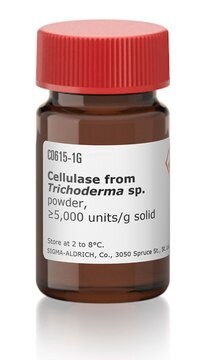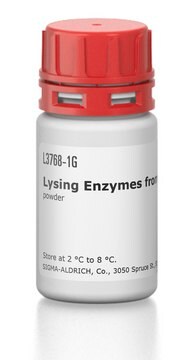P3026
Pectolyase from Aspergillus japonicus
lyophilized powder, ≥0.3 units/mg solid
Synonym(s):
Pectolytic enzyme
About This Item
Recommended Products
biological source
Aspergillus sp. (A. japonicus)
Quality Level
form
lyophilized powder
specific activity
≥0.3 units/mg solid
mol wt
50 kDa
greener alternative product characteristics
Waste Prevention
Design for Energy Efficiency
Learn more about the Principles of Green Chemistry.
sustainability
Greener Alternative Product
greener alternative category
, Enabling
storage temp.
2-8°C
Looking for similar products? Visit Product Comparison Guide
General description
Pectolyase or pectin lyase is stable in the temperature range of 40-50°C and is a 50 kDa enzyme with an isoelectric pH of 3.8.
Application
- in the lysis of chlorella cells for protoplast generation
- as component of enzyme digestion buffer for Arabidopsis meiotic chromosome isolation
- to induce reorganization of Arabidopsis root cap cell architecture
Biochem/physiol Actions
Other Notes
Unit Definition
Storage Class Code
11 - Combustible Solids
WGK
WGK 3
Flash Point(F)
Not applicable
Flash Point(C)
Not applicable
Personal Protective Equipment
Certificates of Analysis (COA)
Search for Certificates of Analysis (COA) by entering the products Lot/Batch Number. Lot and Batch Numbers can be found on a product’s label following the words ‘Lot’ or ‘Batch’.
Already Own This Product?
Find documentation for the products that you have recently purchased in the Document Library.
Customers Also Viewed
Articles
A key resource feature at our Enzyme Explorer section of biochemicals is "Enzymes for Carbohydrate Analysis and Digestion." Offering kits, reagents, analysis, lists of enzymes related to PTM and carbohydrate metabolism.
Our team of scientists has experience in all areas of research including Life Science, Material Science, Chemical Synthesis, Chromatography, Analytical and many others.
Contact Technical Service








